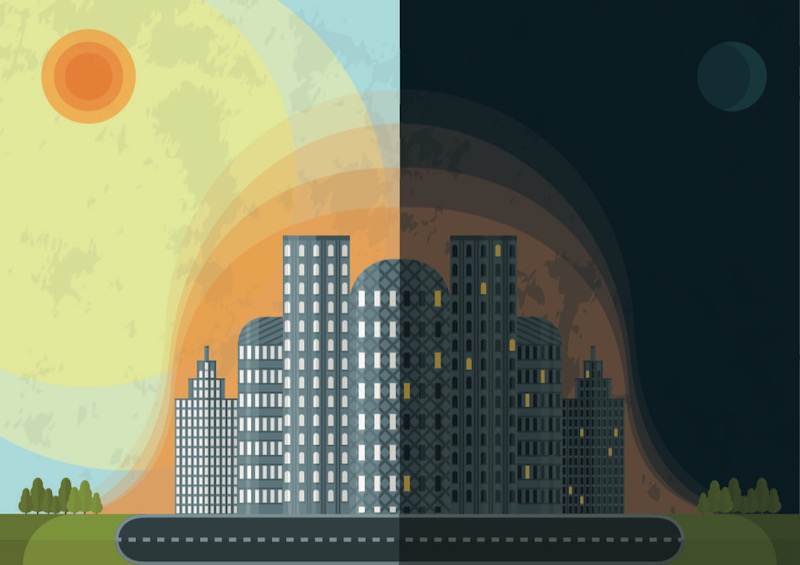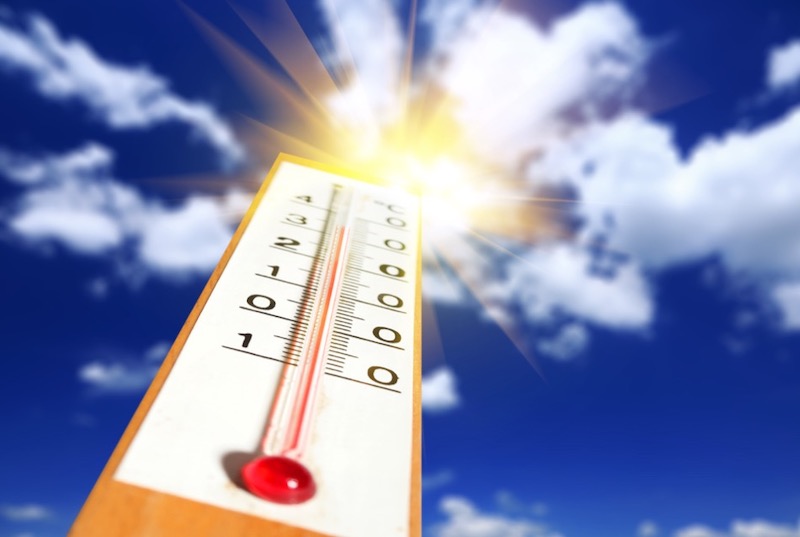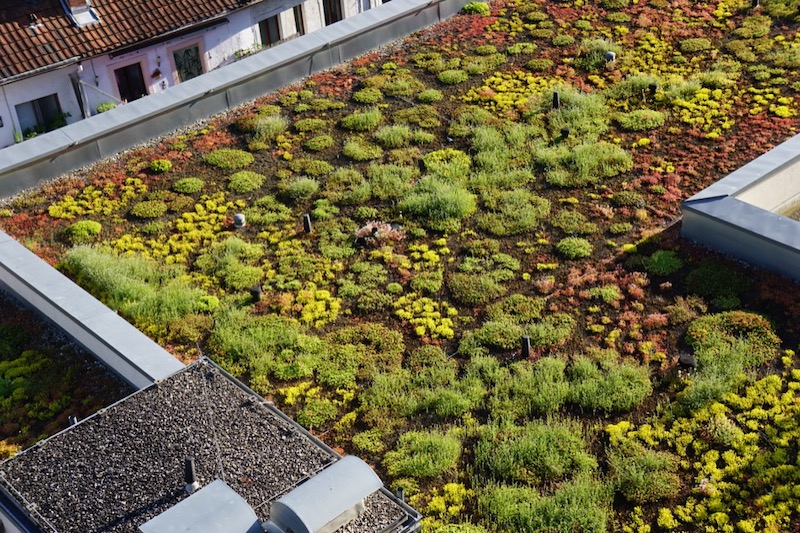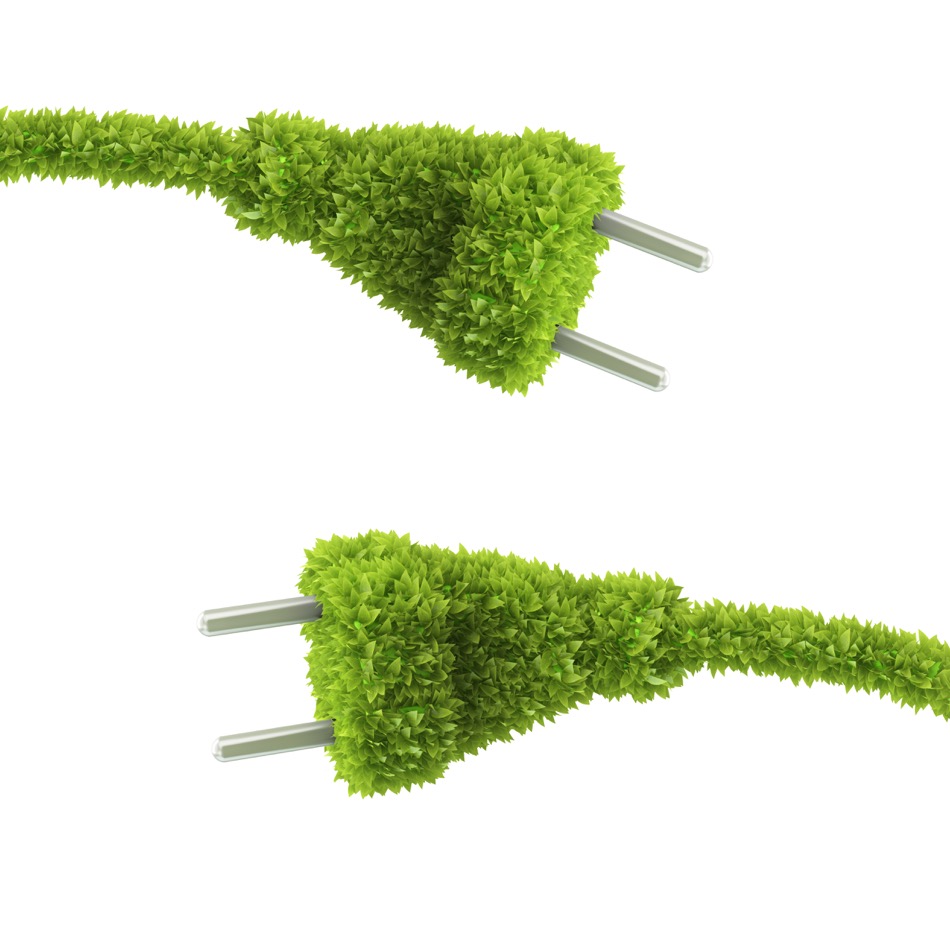Looking for help?
Find answers to your questions
Urban Heat Islands: The Main Issues and What is Being Done to Combat Them
As concerns about climate changes increase, the focus has turned to minimize urban heat islands and their impact on the environment. Urban heat islands are metropolitan areas with much higher temperatures than their surrounding rural areas. In fact, temps can differ as much as 22 degrees Fahrenheit in the right conditions.
The temperature difference mostly comes down to the way urban building materials, including concrete and asphalt, hold and reflect heat. These materials are unable to release heat through transpiration, as plants do, therefore consistently driving temperatures up. Waste heat from furnaces, vehicles, and other machinery used to power and run the city also contributes to the higher temperatures.
The temperatures continue to increase as the city center grows and expands. Oddly enough, the temp difference can be felt most at night and is more apparent in the winter than the summer. Snowy areas in particular experience higher inner-city temperatures in the winter, as less heat is reflected back into the atmosphere.
Furthermore, not all cities become urban heat islands, as there are many contributing factors causing this effect. Areas with high wind speeds or just the right climate characteristics are spared from this phenomenon, for example. For the affected areas, there are many negative effects to consider, making it well worth the time, money, and effort to resolve.
Thankfully, there are near as many potential solutions as there are negative impacts. Explore the topics in this guide to learn all you need to know about urban heat islands.
Negative Effects of Urban Heat Islands
When urban heat islands develop, many negative effects occur as a result. The higher temperatures can impact everything from the local water quality to human health and comfort. The impact can reverberate far from the city center as well, as urban heat islands contribute to global warming.
Before anyone can hope to reverse this phenomenon, they need to understand all these negative impacts and the overall importance of making changes. This way, everyone can confidently get onboard when it comes to mitigating the urban heat island effect.
Increased Energy Consumption
As temperatures rise in urban heat islands, air conditioning equipment has to work double-time to keep up. To keep their buildings at a comfortable temperature, people may crank up their AC units, greatly increasing their energy consumption through the warmer seasons. The need for extra heat in the winter declines, though it does not fully mitigate the higher energy usage.
The bigger the building, the more its energy usage is compounded by the urban heat island effect. These large-scale buildings, common in urban areas, have trouble keeping up with the cooling demands, which can overload their systems.
Unfortunately, it is not only each building’s internal cooling systems at risk — the entire electrical grid is as well. As people run their AC systems on high throughout the days and nights, the city’s electrical system has to work overtime to provide enough power to each structure. If demand outpaces the power supply, city officials may have to use brownouts or even blackouts to prevent the system from overloading and causing a power outage.
Elevated Emissions of Air Pollutants and Greenhouse Gases
The increase in energy consumption due to higher temperatures from urban heat islands causes an elevated output of air pollutants and greenhouse gases. As increased AC usage draws on the local power plants, their release of harmful pollutants increases in kind. Depending on the power source, these pollutants may include:
- Nitrogen oxide
- Mercury
- Sulfur dioxide
- Black carbon
When combined with volatile organic compounds and sunlight, nitrogen oxide creates smog at the ground level. Air quality plummets as a result of the toxic chemicals and fine particles now floating through the air, which people and animals breathe. This problem is likely to get worse, unfortunately, as each effect compounds the next.
As the level of pollutants and greenhouse gas emissions in the air worsen, the urban heat island effect does as well. Unless the underlying causes are addressed, this cycle will continue on, driving temperatures ever upward and dramatically reducing air quality.
Human Health and Comfort
Both the climbing temperatures and poor air quality wreak havoc on human health and comfort in urban heat islands. In these areas, certain people face a higher risk of experiencing heat-related health conditions as temperatures rise, including:
- Babies and young children
- Elderly individuals
- People with asthma or other breathing problems
- Workers who complete their jobs outdoors
- Low-income individuals
Access to air conditioning and other resources can make it easier to weather the higher temperatures, though some people may still experience minor-to-severe health complications. In some cases, heat-related illnesses can cause death. In fact, from 1979 to 2010, at least 8,000 people in the United States died from health problems caused by the heat, though this figure is likely underreported.
For those with underlying health conditions, high temperatures — and the resulting high pollutant concentrations in the air — could mean a trip to the hospital or even a lengthy stay. People with asthma and other breathing problems, for example, may have a hard time taking in enough air on their own, causing their oxygen levels to plummet. When this occurs, they may need breathing treatments and other types of medical assistance to maintain adequate oxygen levels.
Heatwaves do not just impact vulnerable individuals, however, as anyone can succumb to heat-related illnesses, such as heat exhaustion and heatstroke. As the body loses fluid and electrolytes in the heat, heat exhaustion sets in. This condition tends to worsen until the person cools down and replenishes the nutrients.
If exposure to the high temperatures continues, heat stroke could develop, which is life-threatening. With heat stroke, the body loses its ability to cool itself down naturally, allowing internal temperatures to rise.
Across all populations, rising temperatures are also linked to the increased risk of suffering a heart attack. In an attempt to keep body temperature at the right level, the heart has to work harder to pump blood through the vessels near the skin for cooling. This drives up the heart rate and increases the risk of heart attack by one percent for every one-degree increase in temperature.
Animals
In urban heat islands, the surface temperature of the buildings, ground, and other structures is increased. This causes the rain to heat up as it hits these structures and flows down into the drains. Upon reaching nearby streams and rivers, the warm rainwater boosts the temperature of each waterway by as much as 30 degrees, which has a negative impact on all the nearby animal species. Fish, in particular, can go into thermal shock, causing large die-offs of their population in affected areas.
With the higher temperatures, the plant growing season is lengthened, causing animal breeding seasons to extend as well. This cycle effect puts a lot of stress on the natural environment and makes it harder for animals of all kinds to survive the changes.
There are some animals who adapt quite well, however, including:
- Common house geckos
- Ants
- Flying foxes
Unfortunately, this causes even more stress on the natural ecosystem as these species increase in number. Many of the species thriving in urban heat islands are considered pests, demanding cities implement control methods, which can prove costly.
Weather Conditions
Due to their higher temperatures and increased pollution levels, urban heat islands can directly impact the local weather patterns. Average temperatures are not only rising in the day but the night as well. As the cityscape hangs onto more of its heat at night, the difference between daytime and nighttime temperatures decreases.
Urban heat islands are also known to increase the severity and length of heatwaves, increasing the risk to vulnerable populations. Even without global warming complicating things, heatwaves are already much more severe in urban areas due to this effect.
Beyond impacting temperatures, urban heat islands cause many other shifts in weather patterns, such as:
- Increased clouds and fog
- Odd wind pattern shifts
- Additional rain showers and thunderstorms
Areas downwind of the urban heat island also experience altered weather patterns, including much more rainfall each month. The rainfall in those areas can jump by as much as 116 percent, causing a dramatic shift in their ecosystem.
Impaired Water Quality
When pollution levels increase in urban heat islands, water quality declines as a result. Pollutants from power plants, vehicles, and the like tend to combine with water vapor in the air to create acidic compounds. This creates acid rain, which harms everything from metal statues and buildings to humans and wildlife.
As the acid rain falls onto the cityscape, all the pollutants in the air end up in the natural waterways and groundwater. If bad enough, water pollution can wipe out entire species from the local ecosystem, causing a chain reaction of negative effects. Each species relies on the next, after all, to create an environment they can thrive in throughout life.
Humans can also suffer minor to severe health effects from pollutants in their water supply. Depending on the specific pollutants in the water, health conditions ranging from cancer to hormone dysregulation can all occur.
How Urban Heat Islands are Measured
Not all cities turn into urban heat islands, and the severity of the effect varies considerably as well. For this reason, it is necessary for cities to objectively measure temperatures to verify if they are an urban heat island. The measurements also provide a baseline for cities to use as they make improvements to decrease this effect.
In taking these measurements, cities may look at air temps, surface temps, or a combination of the two. Air temperatures provide a look at the city’s living conditions, as it covers ground level to the top of the buildings. Surface temperatures, on the other hand, show how much heat the ground and other surfaces emit at any given time.
Air Temperature Recordings
The air temperature can be recorded using the city’s weather stations, though this only provides a limited view of the space. For additional range, city planners may use cars equipped with weather sensors to take recordings at different points.
Some areas, like Madison, Wisconsin, gather even more data points using sensors mounted on streetlights and utility poles. Still, with these methods, the sensors only pick up a small portion of the city, making it necessary to use models to create the rest of the data.
Measuring Surface Temperatures
To measure surface temperatures, city planners usually rely on data collected from instruments on satellites, showing the city and its surrounding region. Alternatively, they can mount instruments on airplanes to record local surface temperatures on their own.
With their excellent coverage, data from these instruments reveals temperature differences from surface to surface. With a glance at the heat maps, they can differentiate between pavement, rooftops, green spaces, and other key areas. For this reason, looking at surface temps is the best way to evaluate building material changes designed to reduce the urban heat island effect.
Obtaining Complete, Accurate Data
For the best picture of the heat island effect in any given area, city planners must take many measurements across different times of the year. They also need to look at temperatures in both the daytime and nighttime hours, as those data points can vary considerably.
Then, they need to repeat those measurements several times to create a clear overview of the problem. With data from the entire year, they can make improvements to the cityscape and measure their impact in reducing temperatures.
Strategies to Reduce the Heat Island Effect
With a look at all the negative effects caused by urban heat islands, it is clear the world needs a solution and soon. Many cities have started measuring their temperatures and looking at the data to see where to make changes. Together, air and surface temperature data reveal the hot spots in the city and provides direction on where to start first.
Cities have to address each area using proven solutions, which will logistically work in those pockets of the city. Luckily, they have many options at their disposal, as innovative individuals work on slowing climate change in every way possible. Here’s an in-depth look at the many different options available to those interested in reducing the urban heat island effect.
Trees and Vegetation
Trees and vegetation can effectively cool the area by providing shade and through the evapotranspiration process. As plants suck water out of the ground and into their roots, it travels up their stems to their leaves. When it reaches the leaves, small holes allow the water vapor to release back into the air, cooling the nearby area. Through this evapotranspiration process, plants help reduce temperatures, day and night, keeping the area much cooler.
Unfortunately, many cities simply do not have enough trees and vegetation to mitigate the heat island effect. To overcome this problem, cities are making green spaces a top priority. Across all vacant areas, they are planting trees, flowers, and even grass to drive down temperatures. In Louisville, Kentucky, for example, they are expanding their tree canopy to create more shade and use the evapotranspiration process to their advantage.
Not only will their efforts likely reduce temperatures citywide, but it will also help improve water quality as the plants filter pollutants out. Cities do have to plan for a bit more upkeep, however, as the plants need regular care to thrive in the cityscape.
Green Roofs
In cities without much free space, they are looking upward for the solutions with green roofs. These innovative rooftops have a beautiful layer of vegetation, which provides shade and active cooling through evapotranspiration.
A green roof can be as simple or complex as the building owners would like. In some cities, building owners are installing sophisticated garden spaces on their roofs for tenants to enjoy in their free time. Others are simply covering their flat roof with a light substrate and planting hardy groundcover plants across the top.
Both installation types require plenty of preparation to ensure the roof can hold the extra weight and prevent water damage. By adding enough structural support, it is even possible to create a rooftop that can hold full-grown trees. Building owners may need to install new trusses or other support structures to account for the increase in weight.
With either approach, rooftop temperatures decrease by as much as 40 degrees Fahrenheit across the board. Their impact on ambient temperatures is notable too, with many seeing a five-degree drop in temperature. As this occurs, the energy efficiency of the building increases by almost one percent, saving building owners money throughout the year.
When installed across the cityscape, green roofs have the potential to lower temperatures and improve both the air and water quality as a result. They do require regular maintenance and inspections to retain their curb appeal and function, however, but it is well worth the time and expense.
Cool Roofs
Cool roofs can also help reduce the urban heat island effect, though the mechanism is quite different than green roofs. Instead of providing shade and using evapotranspiration to cool the area, these roofs physically reflect the heat.
Since dark colors absorb heat more readily than light ones do, these roofs were first made with light or white materials. Recent advancements in technology have changed all this, however, allowing the creation of cool roofs in darker colors to match the building’s aesthetic.
By reflecting the heat away from the building, surface temperatures at the rooftop sit much lower than their 190-degree norm in full sunlight. The surface temps can decrease by about 60 degrees Fahrenheit in fact, depending on the local climate and building characteristics.
Through a reduction of surface temperatures, air temperatures in the immediate area can start to decline as well. When building owners across the cityscape adopt this approach, they can greatly help mitigate the urban heat island effect in their area.
In addition to decreasing outside temperatures, cool roofs help improve the energy efficiency of the building as well. By preventing roofs from reaching near-boiling temperatures, the inside of the building stays at a reasonable temperature, reducing occupants’ reliance on air conditioning to stay cool and comfortable.
Building owners can also benefit, as the lower temperatures keep the roofing materials in great shape for much longer than normal. Prior to the addition of reflective substances, the deterioration of roofing materials was greatly accelerated as temperatures rose.
Smart Growth
An ounce of prevention is worth a pound of cure — and smart growth practices reflect this mentality. With these preventative practices, city planners are thinking ahead as they build their cities to keep the area from becoming an urban heat island in the first place. They can also use this approach in expanding existing cities into densely populated urban environments.
In building up and expanding the area, they actively avoid the many characteristics turning up the heat across the cityscape, such as:
- Minimal vegetation
- Excessive concrete and asphalt
- Bare roofs made from traditional materials
By properly addressing these elements, city planners can create a cityscape free of the urban heat island effect.
Using Smart-Growth Strategies
With smart-growth practices leading the way, city planners can use a wide range of cooling strategies to keep their region from steadily growing in temperature. Instead of creating a traditional cityscape filled with concrete and commercial buildings, these city planners prefer to mix up the landscape with residential and recreational space as well.
Furthermore, in an effort to preserve green spaces, they focus on compact building design and increasing density through brownfield redevelopment. By promoting infill in these spaces, they preserve 4.5 acres of open land for every acre of redeveloped brownfield.
Other smart growth strategies include:
- Minimizing off-street parking lots
- Using porous pavement
- Planting trees and vegetation
City planners tend to use as many cooling strategies as possible to drive down temperatures and keep them similar to the surrounding rural areas.
Through this approach, they create a cohesive community environment, which is greatly protected from becoming an urban heat island in the future. As the city grows, they can continue to implement their chosen strategies or even add new technologies to the mix as they are invented.
Energy-Efficient Appliances
As temperatures rise, people switch on their air conditioning units to keep their buildings cool and comfortable. While these systems work, they put extra demand on local power plants and produce waste heat, which contributes to the rising temperatures in the city center.
With human health and comfort at risk, it is not reasonable to reduce air conditioner usage — and it is not only AC units causing the problem. All appliances contribute to this effect, especially when they are not built with energy efficiency in mind. Waste heat-producing appliances include:
- Furnaces
- Refrigerators
- Clothes washers and dryers
- Dishwashers
Building owners can determine their own impact on the heat island effect by checking if their appliances are energy efficient. If not, then it is time for a change.
Since it can have such a big effect, everyone in the city center needs to get onboard in outfitting their buildings with energy-efficient appliances. From their inception in 1992, these appliances have helped reduce energy usage by four-trillion kilowatt-hours.
In addition, they have helped keep more than three-billion metric tons of greenhouse gases out of the air. Therefore, with these appliances installed, people can help their cities reduce high temperatures and even improve air and water quality.
The Cool Cities Network
Faced with the same problem, cities have started banding together to fight against the urban heat island effect. Dubbed the Cool Cities Network, this group started in 2005 with just 18 megacities on the roster. Since then, they have grown to 63 cities with many more to join in the coming years.
Through their collaboration, they focus on:
- Recording temperature data across their cityscapes
- Measuring the risk of heat-related health problems to their population
- Create a plan of action for reducing the urban heat island effect
As the cities work on their tasks, they keep the group members well informed of their temperature data, risks, and plan of action. The group provides everyone with resources about the key cooling strategies used to reduce inner-city temperatures. By taking a collaborative approach to this problem, each participating city is making great strides toward limiting the heat differential and protecting their population from harm.
Light-Colored Concrete and White Roofs
As they are highly reflective, light-colored concrete and white roofs have been applauded as a key way to reduce the urban heat island effect. As sunlight shines down on the asphalt, it only reflects four percent back into the atmosphere and holds onto the rest of the heat. White surfaces, on the other hand, can reflect up to 90 percent of the light and heat, keeping the surface much cooler.
If cities commit to transforming their dark roofs using light-colored concrete or white coatings, they can actively reduce their climbing temperatures. A study done by the National Center for Atmospheric Research confirmed this method is the right way to go.
In their research, they found making 90 percent of roofs reflective could drop the heat island effect by one-third. But this isn't all. Other studies revealed that light-colored concrete and white roofs alone could reduce city-center temperatures by almost two degrees.
Cool Pavement
Like rooftops, pavement used for roads, parking lots, and sidewalks tightly hold onto the majority of heat from the sunlight. With a reflection rate of just four percent, these materials reach temperatures of 150 degrees Fahrenheit all summer long, causing heat to radiate all around.
Thankfully, cool pavements are here to help reduce these high surface temperatures — and there are two main types. The first uses reflective materials to reflect sunlight and heat away from the ground. The reflective compounds can be applied to the new and existing pavement, making it a cost-effective solution for cities looking to renovate.
The second type is evaporative pavement, which is porous to allow water to flow through. As the water evaporates, it takes heat with it, mimicking the evapotranspiration process used by plants, which helps cool the area as a result. This type of cool pavement works best in rainy areas, while the reflective pavement is a better choice for everywhere else.
Green Parking Spaces
With parking lots contributing so much to the urban heat island effect, city planners have turned their attention to solving this problem. Most cities have parking lots designed for the maximum number of people coming into the area on busy days. This leaves cities covered in mostly empty parking lots much of the year.
To solve this problem, cities are basing their off-street parking on actual daily numbers rather than peak usage. In addition, they are making public transportation more accessible, reducing the need for parking overall.
City planners are also choosing to make parking stall dimensions smaller, which allows for more vehicles to park in each lot. Although bigger vehicles may need to find alternative parking options, this works for parking a large number of compact cars in a limited space.
Even after minimizing parking-lot footprints, cities still need to replace the pavement surfaces with cool technologies. Using reflective or evaporative pavement helps reduce heat retention and lowers city temperatures considerably.
Heating and Cooling Systems That Can Do Both
Personal vehicles, heavy machinery, and appliances all generate thermal waste as they work. The heating and cooling systems in city buildings are some of the biggest offenders, however, especially when appliances are not upgraded with energy-efficient variants.
Building owners can minimize their impact on the high-city temperatures by utilizing heating and cooling systems that do it all, such as heat pumps. Heat pumps recapture thermal waste and use it to adjust the temperature inside the building.
As they operate, the pumps pull heat held by the pavement, which helps reduce surface temperatures. In addition, these pumps operate without generating excessive waste heat. This also helps reduce high temperatures at the surface while minimizing the energy needed to heat the building.
To cool the building, the pumps act as a heat sink, naturally dropping the temperatures inside. Air conditioners, on the other hand, have to run constantly to cool the hot air, which drives up energy consumption. By taking heat from the ground surfaces and minimizing energy usage, heat pumps can help reduce the urban heat island effect in many cities.
Natural Ventilation
People across the city can help decrease temperatures without consuming excessive energy by using natural ventilation to their advantage. By simply opening up the windows and letting air flow through space, they can create a comfortable space for all to enjoy. If the airflow is not at optimal levels, they can run an energy-efficient fan to move cool air through the building.
With this approach, they can skip the AC most days, reducing the burden on power plants. This is especially effective at night when the temperatures come down a bit. Unfortunately, in areas with a minimal day to night temperature difference, opening windows at night does not have as much of an effect.
Source: LAHomes.com. Urban Heat Islands: The Main Issues and What is Being Done to Combat Them. Retrieved from https://lahomes.com/urban-heat-island-effect/





